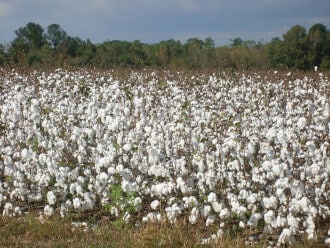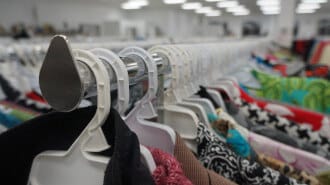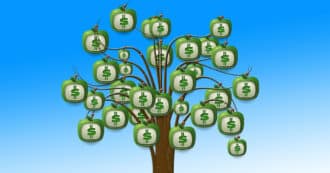By Ethan Keller and Jocelyn Cohn – Have you ever considered that fashion is one of the most polluting industries in the world? Well, it is! Due to low quality material, customers are more likely to buy more clothes which creates more waste. Sustainable clothing offers a solution.
We Need Sustainable Clothes
However, if companies were to spend more money to produce sustainable clothing it would be better quality and customers would want to buy it as well. If fashion brands don’t keep up, eco-friendly options, like more sustainable clothing brands, as well as secondhand clothing stores, will overtake them.
Fast Fashion is Not Sustainable
Clothing produced by a given clothing brand, sold in chain stores, is not expensive for a reason. Fast-fashion, a term invented by Eileen Fisher, entails a few key components, the most important of which is unethical labor in the production process. Workers sew in sweatshops and don’t get even a minimum wage for their work.
This happens in China, India, Bangladesh, and many other places around the world. Another attribute of fast fashion is its abundance of clothing brand “collections”.
Increase in Production
Since the 1960s, clothing brands produce dozens of collections a year. As a consequence, fast fashion is disposable. Clothes are made not to last, so that every year, 13 million tons of textile waste is produced globally.
It is unsustainable for brands to continue creating this much clothing which is detrimental to the environment. This consumerist culture cannot continue any longer.
Impacts of the Clothing Industry on the Environment
Next to oil, the clothing industry is the most polluting industry in the world. One reason is that synthetic fibers like polyester are oil based, and thus contribute to the impacts the petroleum industry has on the environment.
Pollution From the Clothing Industry
In the process that changes raw material into wearable clothing, many steps actively harm the environment. The fertilizers used for non organic cotton production and the chemicals used to treat and dye fabrics end up in rivers, making them polluted. Textile factories emit toxic gasses, including VOCs (volatile organic compounds), which pollute the air and cause health problems for people living near a production site. These factories, powered by coal, account for 10% of global carbon emissions, worsening climate change. And the waste produced by factories, together with millions of tons of clothing thrown away each year, end up in landfills, not decomposing for centuries.
What Is Sustainable Clothing?
Sustainable clothing is ethically made in an ecologically sustainable way and using fair-trade. Buying such clothing reduces one’s ecological footprint and ensures that workers are treated in a just way. Making sustainable clothing means using eco-friendly fabrics and certified organic materials, such as all-natural organic cotton and certified organic hemp, or using recycled materials like recycled nylon. This lessens the industry’s impact on the environment as well as leading to the production of high-quality clothing.
The 3 Pillars of Sustainable Clothing
Whether it’s using organic and fair-trade materials, or treating workers fairly, these 3 pillars of sustainable and ethical clothing can benefit both people and the environment.
The Economics of Sustainable Clothing
Supporting economic development means to support economic growth as well as preserve the quality of the environment. This means that companies use accurate and transparent accounting methods. The profit from the sale of your clothing must cover production, marketing, and management costs.
Impacts of Sustainable Clothing on The Environment
The environment pillar is when the company focuses on reducing their carbon footprint, packaging waste, water usage and their overall effect on the environment.
The Social Impacts of Sustainable Clothing
The company takes social responsibility to treat their employees and neighbors with respect as well as their community. Fair trade clothing is made from fair labor: clothing companies that pay their workers fair wages, provide them with safe working conditions, allowing the workers to organize into unions if they choose.
Disadvantages in Sustainable Clothing Production
It is very expensive to buy and sell clothes. Companies do everything that they can to reduce clothing costs, but by making sustainable clothing or products they are actually raising the costs, even though they are ultimately making better quality clothing. Companies use child labor or sweatshops to lower the costs of clothes production despite it not being ethical and sustainable.
Advantages in Sustainable Clothing Production
So clothing companies may ask, “why be sustainable, when it’s so expensive?” Well, when a company conducts their business sustainably, they are benefitting the earth and those who are buying their products. However, this comes at a literal cost. Sourcing sustainable materials, engaging in ethical labor practices, and conducting the rest of their processes in a way that minimizes their carbon footprint can increase the price range of those sustainable clothing products.
Sustainable Clothing Brands
Sustainable fashion brands such as Oak + Fort and Patagonia (also fair trade certified) puts sustainable practices and eco-friendly materials as their top priority. For example, Oak + Fort actively work to minimize their carbon footprint by partnering with Hallotex which is a company whose goal is to manufacture garments to the highest sustainable standards.
Patagonia’s mission, as a sustainable clothing brand, is to make social and environmental change around the world, while producing their ethical fashion using fair labor practices and natural fibers.
Sustainability Isn’t Just for the Environment
One may perceive sustainability as just helping the environment. However, it also takes economic and social issues into consideration. By shopping sustainably, you are also making certain that child and slave labor are not involved in the process of making your clothing.
This “slow fashion” may be a more expensive process, and out of some consumer’s price range, but the eco-friendly clothing produced by these companies not only benefits the workers they employ, but the sustainable practices don’t harm the environment as much as other processes would.
An Alternative to Sustainable Clothing Brands
In the conversation around sustainable fashion, an afterthought is the use of secondhand clothing, or alternative apparel. According to 2020 GlobalData Market Sizing Estimates, the secondhand clothing market is expected to be twice as big than the fast fashion market by 2030. This includes thrift stores as well as secondhand resale stores.
While owning and wearing secondhand clothing was previously seen as an issue of affordability, there has been a shift in recent years. Younger generations are not only more open to shopping at thrift and secondhand stores, but they are more likely to buy clothing from them over established stores and fashion brands. These stores are sustainable in a number of ways, including using plastic free packaging as well as, of course, not polluting the environment in the numerous ways that fashion brands do.
Sustainable Clothing Options are the Best!
People are fed up with the disposable culture of one-time wear of clothes. One idea for professional women is to create a capsule wardrobe of women’s clothing. This is when you choose a few wardrobe staples, from fabrics like organic cotton or fabrics from sustainable fashion brands produced in factories that are fair trade certified, and then the clothes are mixed and matched repeatedly.
Whether someone purchases clothing made from eco-friendly fabrics, cotton and hemp, recycled materials from certified factories, or chooses to shop at a thrift store, they are all options that are better than shopping at a chain store, where a fashion brand was sewn together by a worker not paid even a living wage.
Faith in Sustainable Fashion
A passage of text from the book “Eco Bible” reads “Exodus 29:29 – The sacral vestments of Aaron shall pass on to his sons after him, for them to be anointed and ordained in.” The Torah describes in great length and detail the eight special garments of the High Priest, which were to be made by hand by embroiderers, weavers, and artisans. Indeed, the clothing of the High Priest is the focus of more Torah verses than any other item aside from the Sanctuary. It is therefore fitting that these garments would not be thrown out upon his death but rather would be used and reused from generation to generation causing zero waste!
A big issue with non-sustainable clothing is their long-term effect on the environment when they are disposed of. By recycling clothing, the process becomes sustainable. This concept even dates back to biblical times!
Reducing the Impact of The Clothing Industry
In Britain today, the average piece of clothing is worn seven times before being thrown out. Some $3.4 billion in clothing is purchased each summer in Britain alone for one-time use at weddings, barbecues, and festivals. Only 1 percent of the material from discarded clothing is recycled. Our use and reuse of clothing has global impacts.
Today, clothing accounts for around 10 percent of global greenhouse gas emissions. Many garments could be worn hundreds of times, repaired, and then worn some more. Donating our used clothes to charity shops, or sharing them with friends and relatives, can reduce lifecycle emissions by over 50 percent (5 percent of global total emissions).
* Featured image source









